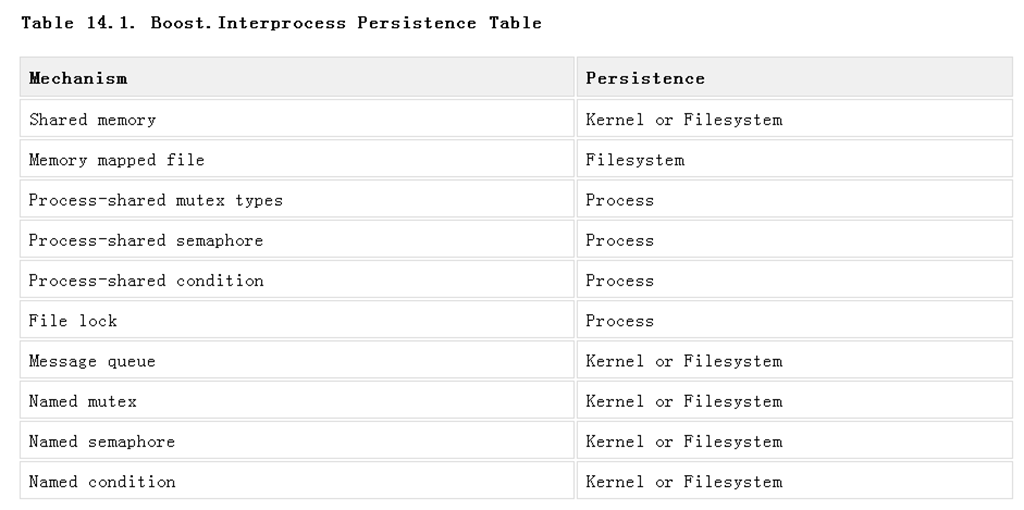Boost IPC Persistence Of Interprocess Mechanisms 例子
下面这一段摘抄自 Boost 1_55_0 的文档,显然标注了 每一个的生命期。
One of the biggest issues with interprocess communication mechanisms is the lifetime of the interprocess communication mechanism. It's important to know when an interprocess communication mechanism disappears from the system. In Boost.Interprocess, we can have 3 types of persistence:
- Process-persistence: The mechanism lasts until all the processes that have opened the mechanism close it, exit or crash.
- Kernel-persistence: The mechanism exists until the kernel of the operating system reboots or the mechanism is explicitly deleted.
- Filesystem-persistence: The mechanism exists until the mechanism is explicitly deleted.
Some native POSIX and Windows IPC mechanisms have different persistence so it's difficult to achieve portability between Windows and POSIX native mechanisms. Boost.Interprocess classes have the following persistence:

As you can see, Boost.Interprocess defines some mechanisms with "Kernel or Filesystem" persistence. This is because POSIX allows this possibility to native interprocess communication implementations. One could, for example, implement shared memory using memory mapped files and obtain filesystem persistence (for example, there is no proper known way to emulate kernel persistence with a user library for Windows shared memory using native shared memory, or process persistence for POSIX shared memory, so the only portable way is to define "Kernel or Filesystem" persistence).
最好的是下面这一个简单的example。
#include <boost/interprocess/shared_memory_object.hpp>
#include <boost/interprocess/mapped_region.hpp>
#include <cstring>
#include <cstdlib>
#include <string>
int main(int argc, char *argv[])
{
using namespace boost::interprocess;
if(argc == 1){ //Parent process
//Remove shared memory on construction and destruction
struct shm_remove
{
shm_remove() { shared_memory_object::remove("MySharedMemory"); }
~shm_remove(){ shared_memory_object::remove("MySharedMemory"); }
} remover;
//Create a shared memory object.
shared_memory_object shm (create_only, "MySharedMemory", read_write);
//Set size
shm.truncate(1000);
//Map the whole shared memory in this process
mapped_region region(shm, read_write);
//Write all the memory to 1
std::memset(region.get_address(), 1, region.get_size());
//Launch child process
std::string s(argv[0]); s += " child ";
if(0 != std::system(s.c_str()))
return 1;
}
else{
//Open already created shared memory object.
shared_memory_object shm (open_only, "MySharedMemory", read_only);
//Map the whole shared memory in this process
mapped_region region(shm, read_only);
//Check that memory was initialized to 1
char *mem = static_cast<char*>(region.get_address());
for(std::size_t i = 0; i < region.get_size(); ++i)
if(*mem++ != 1)
return 1; //Error checking memory
}
return 0;
}
.csharpcode, .csharpcode pre
{
font-size: small;
color: black;
font-family: consolas, "Courier New", courier, monospace;
background-color: #ffffff;
/*white-space: pre;*/
}
.csharpcode pre { margin: 0em; }
.csharpcode .rem { color: #008000; }
.csharpcode .kwrd { color: #0000ff; }
.csharpcode .str { color: #006080; }
.csharpcode .op { color: #0000c0; }
.csharpcode .preproc { color: #cc6633; }
.csharpcode .asp { background-color: #ffff00; }
.csharpcode .html { color: #800000; }
.csharpcode .attr { color: #ff0000; }
.csharpcode .alt
{
background-color: #f4f4f4;
width: 100%;
margin: 0em;
}
.csharpcode .lnum { color: #606060; }
在主进程中创建另一个进程,这个进程来验证之前的共享内存是否被初始化为1。 因为我们的shared memory的生命期是 Kernel 或者是filesystem,所以进程2 是可以验证的。 值得注意一点的是这里的remover,他是一个栈对象,所以每次都销毁,显式调用了 remove,如果去掉这个remover,那么只需要执行一次,以后每次输入这个显式内存都是存在的。因为他的生命期是 kernel 或者filesystem。 所以这里的remover 至关重要!
Boost IPC Persistence Of Interprocess Mechanisms 例子的更多相关文章
- IPC介绍——10个ipcs例子
IPC介绍——10个ipcs例子 semaphorearrays2010performancesystemaccess ipcs是一个uinx/linux的命令.用于报告系统的消息队列.信号量.共享内 ...
- boost库asio详解8——几个TCP的简单例子
摘于boost官网的几个例子, 做了点小修改, 笔记之. 同步客户端 void test_asio_synclient() { typedef boost::asio::io_service IoSe ...
- BOOST 线程完全攻略 - 基础篇
http://blog.csdn.net/iamnieo/article/details/2908621 2008-09-10 12:48 9202人阅读 评论(3) 收藏 举报 thread多线程l ...
- [C++Boost]程序参数项解析库Program_options使用指南
介绍 程序参数项(program options)是一系列name=value对,program_options 允许程序开发者获得通过命令行(command line)和配置文件(config fi ...
- boost::thread类
前言 标准C++线程即将到来.预言它将衍生自Boost线程库,现在让我们探索一下Boost线程库. 几年前,用多线程执行程序还是一件非比寻常的事.然而今天互联网应用服务程序普遍使用多线程来提高与多客户 ...
- Android查缺补漏(IPC篇)-- 进程间通讯基础知识热身
本文作者:CodingBlock 文章链接:http://www.cnblogs.com/codingblock/p/8479282.html 在Android中进程间通信是比较难的一部分,同时又非常 ...
- System V IPC 之共享内存
IPC 是进程间通信(Interprocess Communication)的缩写,通常指允许用户态进程执行系列操作的一组机制: 通过信号量与其他进程进行同步 向其他进程发送消息或者从其他进程接收消息 ...
- 详解 boost 库智能指针(scoped_ptr<T> 、shared_ptr<T> 、weak_ptr<T> 源码分析)
一.boost 智能指针 智能指针是利用RAII(Resource Acquisition Is Initialization:资源获取即初始化)来管理资源.关于RAII的讨论可以参考前面的文章.在使 ...
- Boost总结汇总
从开始接触Boost已经有好几年了,而对它的掌握却难言熟悉,有对它部分的源代码的剖析也是蜻蜓点水.有时间一点点梳理一下吧. 1. 概述 [Boost]C++ Boost库简介[Boost]C++ Bo ...
随机推荐
- servlet 容器,工作原理,优缺点
转自http://blog.sina.com.cn/s/blog_b5a157500101ld71.html servlet:是以java技术为基础,应用于服务器端的程序组件,本质就是java代码,用 ...
- Oracle inactive session (last_call_et)
注意last_call_et的值, select s.status,s.last_call_et,s.* from v$session s where username='DDD'; 在本例中,开了个 ...
- mysql数据库常用语句3
一:查询指定数据库中所有的表名 数据库名:test select table_name from information_schema.tables where table_schema='test' ...
- mysql 导入导出sql文件
使用mysqldump导出sql文件 目前清楚的mysqldump语法是: mysqldump -h[hostname] -u[username] -p [databasename] > [sq ...
- linux+asp.net core+nginx四层负载均衡
Linux Disibutaion:Ubuntu 16.04.1 LTS Web Server:Nginx.Kestrel 关于如何在linux中部署asp.net core我这里不再详细介绍,可以参 ...
- CSS经典布局-圣杯布局、双飞翼布局
圣杯布局的来历是2006年发在a list part上的这篇文章:In Search of the Holy Grail · An A List Apart Article圣杯是西方表达“渴求之物&q ...
- C 中随机数
C语言,如何产生随机数: 基本函数 在C中取随机数所需要对函数是: int rand ( void ); void srand ( unsigned int n); 备注:必须包含该头文件#inclu ...
- UIButton 未响应原因分析
1.父视图响应者链被阻断;例如:在 UILabel,UIImageView 控件添加UIButton,因为UILabel(userInteractionEnabled属性值为NO) 阻断了响应者链,所 ...
- 如果利用storyboard创建cell中标识符identifier的正确设置
今天打算用storyboard直接生成cell,但是总是提示数据源没设置,一直报错. 我就奇了怪了,明明标识符设置了,但是还是不行,仔细分析之后才发想,原来是因为标识符位置填错了.请看下面截图中正确的 ...
- 【html】【17】高级篇--loading加载
参考: http://aspx.sc.chinaz.com/query.aspx?keyword=%E5%8A%A0%E8%BD%BD&classID=835 下载: http://sc. ...
